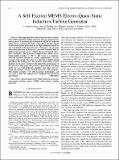| dc.contributor.author | Steyn, J. Lodewyk | |
| dc.contributor.author | Kendig, Sam H. | |
| dc.contributor.author | Khanna, Ravi | |
| dc.contributor.author | Umans, Stephen D. | |
| dc.contributor.author | Lang, Jeffrey H. | |
| dc.contributor.author | Livermore, Carol | |
| dc.date.accessioned | 2011-03-07T20:44:49Z | |
| dc.date.available | 2011-03-07T20:44:49Z | |
| dc.date.issued | 2009-04 | |
| dc.date.submitted | 2008-08 | |
| dc.identifier.issn | 1057-7157 | |
| dc.identifier.uri | http://hdl.handle.net/1721.1/61619 | |
| dc.description.abstract | This paper presents a microfabricated electro-quasi-static
(EQS) induction turbine generator that has generated net
electric power. A maximum power output of 192 μW [mu W]was achieved
under driven excitation. We believe that this is the first report
of net-electric-power generation by an EQS induction machine of
any scale found in the open literature. This paper also presents
self-excited operation in which the generator resonates with an
inductor and generates power without the use of external active-drive
electronics. The generator comprises five silicon layers,
fusion-bonded together at 700 ◦C [degrees C]. The stator is a platinum-electrode
structure formed on a thick (approximately 20 μm [mu m])
recessed oxide island. The rotor is a thin film of lightly doped
polysilicon also residing on a 10-μm [mu m]-thick oxide island. Carrier
depletion in the rotor conductor film limited the performance of
the generator. This paper also presents a generalized state-space
model for an EQS induction machine that takes into account
the machine and its external electronics and parasitics.
This model correlates well with measured performance and
was used to find the optimal drive conditions for all driven
experiments. | en_US |
| dc.description.sponsorship | United States. Army Research Laboratory (DAAD19-01-2-0010) | en_US |
| dc.description.sponsorship | United States. Army Research Office (DAAG55-98-1-0292) | en_US |
| dc.description.sponsorship | United States. Defense Advanced Research Projects Agency (Air Force contract F19628-00-C-0002) | en_US |
| dc.description.sponsorship | Collaborative Technology Alliance In Power And Energy Program | en_US |
| dc.language.iso | en_US | |
| dc.publisher | Institute of Electrical and Electronics Engineers / American Society of Mechanical Engineers | en_US |
| dc.relation.isversionof | http://dx.doi.org/10.1109/JMEMS.2008.2011692 | en_US |
| dc.rights | Article is made available in accordance with the publisher's policy and may be subject to US copyright law. Please refer to the publisher's site for terms of use. | en_US |
| dc.source | IEEE | en_US |
| dc.title | A self-excited MEMS electro-quasi-static induction turbine generator | en_US |
| dc.type | Article | en_US |
| dc.identifier.citation | Steyn, J.L. et al. “A Self-Excited MEMS Electro-Quasi-Static Induction Turbine Generator.” Microelectromechanical Systems, Journal of 18.2 (2009): 424-432. © 2009, IEEE | en_US |
| dc.contributor.department | Massachusetts Institute of Technology. Department of Electrical Engineering and Computer Science | en_US |
| dc.contributor.department | Massachusetts Institute of Technology. Department of Mechanical Engineering | en_US |
| dc.contributor.approver | Livermore, Carol | |
| dc.contributor.mitauthor | Lang, Jeffrey H. | |
| dc.contributor.mitauthor | Livermore, Carol | |
| dc.relation.journal | Journal of Microelectromechanical Systems | en_US |
| dc.eprint.version | Final published version | en_US |
| dc.type.uri | http://purl.org/eprint/type/ConferencePaper | en_US |
| dspace.orderedauthors | Steyn, J.L.; Kendig, S.H.; Khanna, R.; Umans, S.D.; Lang, J.H.; Livermore, C. | en |
| dc.identifier.orcid | https://orcid.org/0000-0002-5765-4369 | |
| mit.license | PUBLISHER_POLICY | en_US |
| mit.metadata.status | Complete | |
